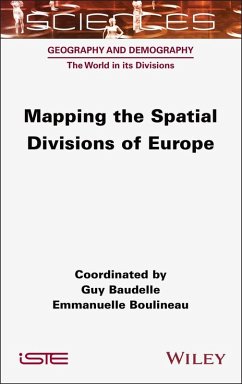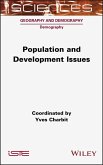142,99 €
142,99 €
inkl. MwSt.
Sofort per Download lieferbar

0 °P sammeln
142,99 €
Als Download kaufen

142,99 €
inkl. MwSt.
Sofort per Download lieferbar

0 °P sammeln
Jetzt verschenken
Alle Infos zum eBook verschenken
142,99 €
inkl. MwSt.
Sofort per Download lieferbar
Alle Infos zum eBook verschenken

0 °P sammeln
- Format: ePub
- Merkliste
- Auf die Merkliste
- Bewerten Bewerten
- Teilen
- Produkt teilen
- Produkterinnerung
- Produkterinnerung

Bitte loggen Sie sich zunächst in Ihr Kundenkonto ein oder registrieren Sie sich bei
bücher.de, um das eBook-Abo tolino select nutzen zu können.
Hier können Sie sich einloggen
Hier können Sie sich einloggen
Sie sind bereits eingeloggt. Klicken Sie auf 2. tolino select Abo, um fortzufahren.

Bitte loggen Sie sich zunächst in Ihr Kundenkonto ein oder registrieren Sie sich bei bücher.de, um das eBook-Abo tolino select nutzen zu können.
The European continent has given rise to the greatest number of spatial divisions. Its limits have provoked numerous debates, both within and outside of the continent. The European Union, for its part, has become a laboratory for the production of divisions. Each of these divisions, a vector of identity and territoriality, reflects an intentionality, as revealed in Mapping the Spatial Divisions of Europe. The book shows the multiplicity of forms and modalities of these divisions and the actors who produce, use and question them in a globalized, and reticular world. From the continent as a…mehr
- Geräte: eReader
- mit Kopierschutz
- eBook Hilfe
- Größe: 10.2MB
Andere Kunden interessierten sich auch für
![Mapping the Spatial Divisions of Europe (eBook, PDF) Mapping the Spatial Divisions of Europe (eBook, PDF)]() Guy BaudelleMapping the Spatial Divisions of Europe (eBook, PDF)142,99 €
Guy BaudelleMapping the Spatial Divisions of Europe (eBook, PDF)142,99 €![The New American Suburb (eBook, ePUB) The New American Suburb (eBook, ePUB)]() The New American Suburb (eBook, ePUB)46,95 €
The New American Suburb (eBook, ePUB)46,95 €![War, Violence, and Population (eBook, ePUB) War, Violence, and Population (eBook, ePUB)]() James A. TynerWar, Violence, and Population (eBook, ePUB)35,95 €
James A. TynerWar, Violence, and Population (eBook, ePUB)35,95 €![Territorial Division for Public Action (eBook, ePUB) Territorial Division for Public Action (eBook, ePUB)]() Antoine LaporteTerritorial Division for Public Action (eBook, ePUB)142,99 €
Antoine LaporteTerritorial Division for Public Action (eBook, ePUB)142,99 €![Working Lives (eBook, ePUB) Working Lives (eBook, ePUB)]() Linda McdowellWorking Lives (eBook, ePUB)25,99 €
Linda McdowellWorking Lives (eBook, ePUB)25,99 €![Population Geography (eBook, ePUB) Population Geography (eBook, ePUB)]() Helen D. HazenPopulation Geography (eBook, ePUB)38,95 €
Helen D. HazenPopulation Geography (eBook, ePUB)38,95 €![Population and Development Issues (eBook, ePUB) Population and Development Issues (eBook, ePUB)]() Population and Development Issues (eBook, ePUB)126,99 €
Population and Development Issues (eBook, ePUB)126,99 €-
-
-
The European continent has given rise to the greatest number of spatial divisions. Its limits have provoked numerous debates, both within and outside of the continent. The European Union, for its part, has become a laboratory for the production of divisions. Each of these divisions, a vector of identity and territoriality, reflects an intentionality, as revealed in Mapping the Spatial Divisions of Europe. The book shows the multiplicity of forms and modalities of these divisions and the actors who produce, use and question them in a globalized, and reticular world. From the continent as a whole to the individual regions via metropolitan areas and their networks, from meshing to zoning, from regionalization to representations, this book explores how these divisions are used to govern, plan, imagine and build European territories beyond the heritage of states and their borders. The chapters shed new light on the theoretical and practical issues involved in carving Europe on different time and space scales.
Dieser Download kann aus rechtlichen Gründen nur mit Rechnungsadresse in D ausgeliefert werden.
Produktdetails
- Produktdetails
- Verlag: John Wiley & Sons
- Seitenzahl: 425
- Erscheinungstermin: 15. Juli 2025
- Englisch
- ISBN-13: 9781394393657
- Artikelnr.: 74932522
- Verlag: John Wiley & Sons
- Seitenzahl: 425
- Erscheinungstermin: 15. Juli 2025
- Englisch
- ISBN-13: 9781394393657
- Artikelnr.: 74932522
- Herstellerkennzeichnung Die Herstellerinformationen sind derzeit nicht verfügbar.
Guy Baudelle is Professor Emeritus of Spatial Planning at the University of Rennes 2, France. He is also a member of the UMR CNRS ESO research unit and former Jean Monnet Chair (2003-2022). His work focuses on territorial development policies in the European Union and France.
Emmanuelle Boulineau is Professor of Geography at the École normale supérieure de Lyon, France, and a member of the CNRS EVS research unit. She specializes in the political geography of territorial reform in Europe, particularly in Central and Eastern Europe.
Emmanuelle Boulineau is Professor of Geography at the École normale supérieure de Lyon, France, and a member of the CNRS EVS research unit. She specializes in the political geography of territorial reform in Europe, particularly in Central and Eastern Europe.
Introduction xi
Guy BAUDELLE and Emmanuelle BOULINEAU
Part 1. Europe and Its Divisions: A Matter of Scale, Time and Perspective 1
Chapter 1. Europe, a Region with Variable Geography 3
Yann RICHARD
1.1. Introduction 3
1.2. Europe between globalization and (macro)regionalization: from
continent to functional macroregion 4
1.3. European community: an undefinable regional political object without
limit? 10
1.4. Europe and its divisions, old and new 14
1.5. Conclusion 20
1.6. References 22
Chapter 2. Europe, a Continent? A Geohistorical Analysis 25
Vincent CAPDEPUY
2.1. Introduction 25
2.2. A division with a history 26
2.3. A territory 36
2.4. Conclusion: an empty shell? 47
2.5. References 47
Chapter 3. The Dissemination of European Administrative Divisions
throughout the World 49
Nathalie FAU, Stéphanie LIMA, Hubert MAZUREK and Julien THOREZ
3.1. Introduction 49
3.2. The Western European model of the nation-state: dissemination and new
divisions 51
3.3. Internal divisions: adaptation, resurgence and innovation 57
3.4. The Europeanization or regionalization of the world? 63
3.5. Conclusion 67
3.6. References 69
Part 2. Divisions of Europe by the European Union 75
Chapter 4. Three Patterns of Territorial Division: NUTS, Macroregions and
Cross-border Areas 77
Emmanuelle BOULINEAU
4.1. Introduction 77
4.2. NUTS: a European gridding beyond the simple carving up of space 78
4.3. Macroregions: discontinuous, supraregional, integrational zoning with
fuzzy stakes 83
4.4. Cross-border spaces: a typology for European integration and cohesion
87
4.5. Understanding the impact of the three patterns of territorial division
in the construction of Europe 92
4.6. References 95
Chapter 5. Dividing the EU for Its Own Development 97
Frédéric SANTAMARIA
5.1. EU action without territory or legal authority 97
5.2. EU promotion of regional divisions versus the diversity of choices in
the organization of national territory 99
5.3. More territorialized EU action: a desire confined to certain areas 104
5.4. The idea of (right) (territorial) governance as a substitute for
divisions 116
5.5. Conclusion 119
5.6. References 119
Chapter 6. The Blue Banana or the Influence of Symbolic Divisions on Our
Representations of Europe 123
Guy BAUDELLE
6.1. Introduction 123
6.2. The theoretical framework: the power of symbolic representations of
space 124
6.3. The thunderclap of the blue banana 126
6.4. The effect of a division on public action 132
6.5. Lessons from an enduring episode 134
6.6. Conclusion 137
6.7. References 138
Part 3. Questioning Europe's Divisions 145
Chapter 7. The Difficulty in Adjusting Metropolitan Perimeters 147
Marianne GUÉROIS, Brice LAMENIE, Dominique RIVIÈRE and Anne BRETAGNOLLE
7.1. Introduction 147
7.2. The evolution of functional metropolitan divisions in Europe 149
7.3. Institutional perimeters tested by metropolitan challenges 157
7.4. Conclusion 167
7.5. References 169
Chapter 8. Urban/Rural Divisions in Europe 173
Samuel DEPRAZ
8.1. Introduction 173
8.2. Why a rural spatial notion?. 174
8.3. Dividing the countryside: guidelines 179
8.4. Conclusion 187
8.5. References 188
Chapter 9. Europe, Water and Divisions: River Basin Districts and Bodies of
Water 193
Stéphane GHIOTTI and Anne RIVIÈRE-HONEGGER
9.1. Introduction 193
9.2. A Europeanization of divisions in the face of environmental diversity,
challenges and national policies 196
9.3. The European Water Framework Directive (WFD 2000), an initiator of new
divisions 202
9.4. Two divisions put to the test: the hydrographic district and the body
of water 207
9.5. Conclusion 211
9.6. References 213
Chapter 10. Reticular Divisions for Transportation 219
Antoine BEYER
10.1. Introduction: rethinking territorial divisions based on the
Trans-European Transportation Network 219
10.2. The development of transportation as an allegory for overcoming
borders 221
10.3. Technical systems still largely influenced by national borders 222
10.4. Hybridization of technical apparatuses: the proliferation and spread
of borders in railway networks 224
10.5. Pre-community transportation systems, the hidden dimension of
European integration before the EU 227
10.6. The core network: the stages of creating a community doctrine for
transportation networks 229
10.7. Eurocorridors: laboratories for European integration 233
10.8. From division by corridor to development axes 235
10.9. Conclusion: corridors, powerful vectors for the territorialization of
EU policies 238
10.10. References 239
Chapter 11. Networked Cities 241
Ninon BRIOT
11.1. Introduction 241
11.2. Constructing a unified EU through cooperation between cities crossing
State borders 244
11.3. Deconstructing EU links 248
11.4. Surpassing EU borders: international cooperation to connect with the
rest of the world 253
11.5. References 260
List of Authors 263
Index 265
Guy BAUDELLE and Emmanuelle BOULINEAU
Part 1. Europe and Its Divisions: A Matter of Scale, Time and Perspective 1
Chapter 1. Europe, a Region with Variable Geography 3
Yann RICHARD
1.1. Introduction 3
1.2. Europe between globalization and (macro)regionalization: from
continent to functional macroregion 4
1.3. European community: an undefinable regional political object without
limit? 10
1.4. Europe and its divisions, old and new 14
1.5. Conclusion 20
1.6. References 22
Chapter 2. Europe, a Continent? A Geohistorical Analysis 25
Vincent CAPDEPUY
2.1. Introduction 25
2.2. A division with a history 26
2.3. A territory 36
2.4. Conclusion: an empty shell? 47
2.5. References 47
Chapter 3. The Dissemination of European Administrative Divisions
throughout the World 49
Nathalie FAU, Stéphanie LIMA, Hubert MAZUREK and Julien THOREZ
3.1. Introduction 49
3.2. The Western European model of the nation-state: dissemination and new
divisions 51
3.3. Internal divisions: adaptation, resurgence and innovation 57
3.4. The Europeanization or regionalization of the world? 63
3.5. Conclusion 67
3.6. References 69
Part 2. Divisions of Europe by the European Union 75
Chapter 4. Three Patterns of Territorial Division: NUTS, Macroregions and
Cross-border Areas 77
Emmanuelle BOULINEAU
4.1. Introduction 77
4.2. NUTS: a European gridding beyond the simple carving up of space 78
4.3. Macroregions: discontinuous, supraregional, integrational zoning with
fuzzy stakes 83
4.4. Cross-border spaces: a typology for European integration and cohesion
87
4.5. Understanding the impact of the three patterns of territorial division
in the construction of Europe 92
4.6. References 95
Chapter 5. Dividing the EU for Its Own Development 97
Frédéric SANTAMARIA
5.1. EU action without territory or legal authority 97
5.2. EU promotion of regional divisions versus the diversity of choices in
the organization of national territory 99
5.3. More territorialized EU action: a desire confined to certain areas 104
5.4. The idea of (right) (territorial) governance as a substitute for
divisions 116
5.5. Conclusion 119
5.6. References 119
Chapter 6. The Blue Banana or the Influence of Symbolic Divisions on Our
Representations of Europe 123
Guy BAUDELLE
6.1. Introduction 123
6.2. The theoretical framework: the power of symbolic representations of
space 124
6.3. The thunderclap of the blue banana 126
6.4. The effect of a division on public action 132
6.5. Lessons from an enduring episode 134
6.6. Conclusion 137
6.7. References 138
Part 3. Questioning Europe's Divisions 145
Chapter 7. The Difficulty in Adjusting Metropolitan Perimeters 147
Marianne GUÉROIS, Brice LAMENIE, Dominique RIVIÈRE and Anne BRETAGNOLLE
7.1. Introduction 147
7.2. The evolution of functional metropolitan divisions in Europe 149
7.3. Institutional perimeters tested by metropolitan challenges 157
7.4. Conclusion 167
7.5. References 169
Chapter 8. Urban/Rural Divisions in Europe 173
Samuel DEPRAZ
8.1. Introduction 173
8.2. Why a rural spatial notion?. 174
8.3. Dividing the countryside: guidelines 179
8.4. Conclusion 187
8.5. References 188
Chapter 9. Europe, Water and Divisions: River Basin Districts and Bodies of
Water 193
Stéphane GHIOTTI and Anne RIVIÈRE-HONEGGER
9.1. Introduction 193
9.2. A Europeanization of divisions in the face of environmental diversity,
challenges and national policies 196
9.3. The European Water Framework Directive (WFD 2000), an initiator of new
divisions 202
9.4. Two divisions put to the test: the hydrographic district and the body
of water 207
9.5. Conclusion 211
9.6. References 213
Chapter 10. Reticular Divisions for Transportation 219
Antoine BEYER
10.1. Introduction: rethinking territorial divisions based on the
Trans-European Transportation Network 219
10.2. The development of transportation as an allegory for overcoming
borders 221
10.3. Technical systems still largely influenced by national borders 222
10.4. Hybridization of technical apparatuses: the proliferation and spread
of borders in railway networks 224
10.5. Pre-community transportation systems, the hidden dimension of
European integration before the EU 227
10.6. The core network: the stages of creating a community doctrine for
transportation networks 229
10.7. Eurocorridors: laboratories for European integration 233
10.8. From division by corridor to development axes 235
10.9. Conclusion: corridors, powerful vectors for the territorialization of
EU policies 238
10.10. References 239
Chapter 11. Networked Cities 241
Ninon BRIOT
11.1. Introduction 241
11.2. Constructing a unified EU through cooperation between cities crossing
State borders 244
11.3. Deconstructing EU links 248
11.4. Surpassing EU borders: international cooperation to connect with the
rest of the world 253
11.5. References 260
List of Authors 263
Index 265
Introduction xi
Guy BAUDELLE and Emmanuelle BOULINEAU
Part 1. Europe and Its Divisions: A Matter of Scale, Time and Perspective 1
Chapter 1. Europe, a Region with Variable Geography 3
Yann RICHARD
1.1. Introduction 3
1.2. Europe between globalization and (macro)regionalization: from
continent to functional macroregion 4
1.3. European community: an undefinable regional political object without
limit? 10
1.4. Europe and its divisions, old and new 14
1.5. Conclusion 20
1.6. References 22
Chapter 2. Europe, a Continent? A Geohistorical Analysis 25
Vincent CAPDEPUY
2.1. Introduction 25
2.2. A division with a history 26
2.3. A territory 36
2.4. Conclusion: an empty shell? 47
2.5. References 47
Chapter 3. The Dissemination of European Administrative Divisions
throughout the World 49
Nathalie FAU, Stéphanie LIMA, Hubert MAZUREK and Julien THOREZ
3.1. Introduction 49
3.2. The Western European model of the nation-state: dissemination and new
divisions 51
3.3. Internal divisions: adaptation, resurgence and innovation 57
3.4. The Europeanization or regionalization of the world? 63
3.5. Conclusion 67
3.6. References 69
Part 2. Divisions of Europe by the European Union 75
Chapter 4. Three Patterns of Territorial Division: NUTS, Macroregions and
Cross-border Areas 77
Emmanuelle BOULINEAU
4.1. Introduction 77
4.2. NUTS: a European gridding beyond the simple carving up of space 78
4.3. Macroregions: discontinuous, supraregional, integrational zoning with
fuzzy stakes 83
4.4. Cross-border spaces: a typology for European integration and cohesion
87
4.5. Understanding the impact of the three patterns of territorial division
in the construction of Europe 92
4.6. References 95
Chapter 5. Dividing the EU for Its Own Development 97
Frédéric SANTAMARIA
5.1. EU action without territory or legal authority 97
5.2. EU promotion of regional divisions versus the diversity of choices in
the organization of national territory 99
5.3. More territorialized EU action: a desire confined to certain areas 104
5.4. The idea of (right) (territorial) governance as a substitute for
divisions 116
5.5. Conclusion 119
5.6. References 119
Chapter 6. The Blue Banana or the Influence of Symbolic Divisions on Our
Representations of Europe 123
Guy BAUDELLE
6.1. Introduction 123
6.2. The theoretical framework: the power of symbolic representations of
space 124
6.3. The thunderclap of the blue banana 126
6.4. The effect of a division on public action 132
6.5. Lessons from an enduring episode 134
6.6. Conclusion 137
6.7. References 138
Part 3. Questioning Europe's Divisions 145
Chapter 7. The Difficulty in Adjusting Metropolitan Perimeters 147
Marianne GUÉROIS, Brice LAMENIE, Dominique RIVIÈRE and Anne BRETAGNOLLE
7.1. Introduction 147
7.2. The evolution of functional metropolitan divisions in Europe 149
7.3. Institutional perimeters tested by metropolitan challenges 157
7.4. Conclusion 167
7.5. References 169
Chapter 8. Urban/Rural Divisions in Europe 173
Samuel DEPRAZ
8.1. Introduction 173
8.2. Why a rural spatial notion?. 174
8.3. Dividing the countryside: guidelines 179
8.4. Conclusion 187
8.5. References 188
Chapter 9. Europe, Water and Divisions: River Basin Districts and Bodies of
Water 193
Stéphane GHIOTTI and Anne RIVIÈRE-HONEGGER
9.1. Introduction 193
9.2. A Europeanization of divisions in the face of environmental diversity,
challenges and national policies 196
9.3. The European Water Framework Directive (WFD 2000), an initiator of new
divisions 202
9.4. Two divisions put to the test: the hydrographic district and the body
of water 207
9.5. Conclusion 211
9.6. References 213
Chapter 10. Reticular Divisions for Transportation 219
Antoine BEYER
10.1. Introduction: rethinking territorial divisions based on the
Trans-European Transportation Network 219
10.2. The development of transportation as an allegory for overcoming
borders 221
10.3. Technical systems still largely influenced by national borders 222
10.4. Hybridization of technical apparatuses: the proliferation and spread
of borders in railway networks 224
10.5. Pre-community transportation systems, the hidden dimension of
European integration before the EU 227
10.6. The core network: the stages of creating a community doctrine for
transportation networks 229
10.7. Eurocorridors: laboratories for European integration 233
10.8. From division by corridor to development axes 235
10.9. Conclusion: corridors, powerful vectors for the territorialization of
EU policies 238
10.10. References 239
Chapter 11. Networked Cities 241
Ninon BRIOT
11.1. Introduction 241
11.2. Constructing a unified EU through cooperation between cities crossing
State borders 244
11.3. Deconstructing EU links 248
11.4. Surpassing EU borders: international cooperation to connect with the
rest of the world 253
11.5. References 260
List of Authors 263
Index 265
Guy BAUDELLE and Emmanuelle BOULINEAU
Part 1. Europe and Its Divisions: A Matter of Scale, Time and Perspective 1
Chapter 1. Europe, a Region with Variable Geography 3
Yann RICHARD
1.1. Introduction 3
1.2. Europe between globalization and (macro)regionalization: from
continent to functional macroregion 4
1.3. European community: an undefinable regional political object without
limit? 10
1.4. Europe and its divisions, old and new 14
1.5. Conclusion 20
1.6. References 22
Chapter 2. Europe, a Continent? A Geohistorical Analysis 25
Vincent CAPDEPUY
2.1. Introduction 25
2.2. A division with a history 26
2.3. A territory 36
2.4. Conclusion: an empty shell? 47
2.5. References 47
Chapter 3. The Dissemination of European Administrative Divisions
throughout the World 49
Nathalie FAU, Stéphanie LIMA, Hubert MAZUREK and Julien THOREZ
3.1. Introduction 49
3.2. The Western European model of the nation-state: dissemination and new
divisions 51
3.3. Internal divisions: adaptation, resurgence and innovation 57
3.4. The Europeanization or regionalization of the world? 63
3.5. Conclusion 67
3.6. References 69
Part 2. Divisions of Europe by the European Union 75
Chapter 4. Three Patterns of Territorial Division: NUTS, Macroregions and
Cross-border Areas 77
Emmanuelle BOULINEAU
4.1. Introduction 77
4.2. NUTS: a European gridding beyond the simple carving up of space 78
4.3. Macroregions: discontinuous, supraregional, integrational zoning with
fuzzy stakes 83
4.4. Cross-border spaces: a typology for European integration and cohesion
87
4.5. Understanding the impact of the three patterns of territorial division
in the construction of Europe 92
4.6. References 95
Chapter 5. Dividing the EU for Its Own Development 97
Frédéric SANTAMARIA
5.1. EU action without territory or legal authority 97
5.2. EU promotion of regional divisions versus the diversity of choices in
the organization of national territory 99
5.3. More territorialized EU action: a desire confined to certain areas 104
5.4. The idea of (right) (territorial) governance as a substitute for
divisions 116
5.5. Conclusion 119
5.6. References 119
Chapter 6. The Blue Banana or the Influence of Symbolic Divisions on Our
Representations of Europe 123
Guy BAUDELLE
6.1. Introduction 123
6.2. The theoretical framework: the power of symbolic representations of
space 124
6.3. The thunderclap of the blue banana 126
6.4. The effect of a division on public action 132
6.5. Lessons from an enduring episode 134
6.6. Conclusion 137
6.7. References 138
Part 3. Questioning Europe's Divisions 145
Chapter 7. The Difficulty in Adjusting Metropolitan Perimeters 147
Marianne GUÉROIS, Brice LAMENIE, Dominique RIVIÈRE and Anne BRETAGNOLLE
7.1. Introduction 147
7.2. The evolution of functional metropolitan divisions in Europe 149
7.3. Institutional perimeters tested by metropolitan challenges 157
7.4. Conclusion 167
7.5. References 169
Chapter 8. Urban/Rural Divisions in Europe 173
Samuel DEPRAZ
8.1. Introduction 173
8.2. Why a rural spatial notion?. 174
8.3. Dividing the countryside: guidelines 179
8.4. Conclusion 187
8.5. References 188
Chapter 9. Europe, Water and Divisions: River Basin Districts and Bodies of
Water 193
Stéphane GHIOTTI and Anne RIVIÈRE-HONEGGER
9.1. Introduction 193
9.2. A Europeanization of divisions in the face of environmental diversity,
challenges and national policies 196
9.3. The European Water Framework Directive (WFD 2000), an initiator of new
divisions 202
9.4. Two divisions put to the test: the hydrographic district and the body
of water 207
9.5. Conclusion 211
9.6. References 213
Chapter 10. Reticular Divisions for Transportation 219
Antoine BEYER
10.1. Introduction: rethinking territorial divisions based on the
Trans-European Transportation Network 219
10.2. The development of transportation as an allegory for overcoming
borders 221
10.3. Technical systems still largely influenced by national borders 222
10.4. Hybridization of technical apparatuses: the proliferation and spread
of borders in railway networks 224
10.5. Pre-community transportation systems, the hidden dimension of
European integration before the EU 227
10.6. The core network: the stages of creating a community doctrine for
transportation networks 229
10.7. Eurocorridors: laboratories for European integration 233
10.8. From division by corridor to development axes 235
10.9. Conclusion: corridors, powerful vectors for the territorialization of
EU policies 238
10.10. References 239
Chapter 11. Networked Cities 241
Ninon BRIOT
11.1. Introduction 241
11.2. Constructing a unified EU through cooperation between cities crossing
State borders 244
11.3. Deconstructing EU links 248
11.4. Surpassing EU borders: international cooperation to connect with the
rest of the world 253
11.5. References 260
List of Authors 263
Index 265







